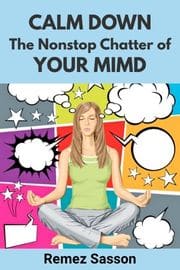
What is mantra meditation? How to practice it?
In this article, we will explain what is a mantra, what is mantra meditation, and how to practice it.
This practice is simple yet highly effective in improving focus, calming the mind and reducing the number of thoughts that distract the mind.
Table of Contents:
What Is a Mantra?
First, let’s define the word mantra and understand its meaning, and then explain how to use it.
Mantra definition – This word means a sound or a short phrase that is repeated over and again for the purpose of focusing the mind and calming down its restlessness.
A mantra can be the sound “OM”, a short inspiring sentence, or a positive and relaxing word, such “peace”, “happiness” or “serenity”.
The origin of the word comes from the East, where it is often used for the purpose of disciplining the mind.
In the East, a mantra is considered as a sacred utterance, word, or group of words believed to have psychological and spiritual powers. Repeating it can induce an altered state of consciousness.
Focusing on a mantra teaches your mind to focus on one word or sound and to disregard other thoughts that try to attract its attention. This action calms down the nonstop chatter and restlessness of the mind.
Weekly lessons with stories, insights, and practical guidance to help you step beyond ordinary routines and awaken deeper awareness in daily life.
👉 Read a Sample Inner Awakening lesson
Now that we know what is a mantra let’s explain how to use it in meditation.
What Is Mantra Meditation
Mantra meditation is a simple technique of repeating a word or sound and focusing your complete attention on it.
This technique is effective for controlling the attention and ignoring unrelated thoughts. This leads to better focus, inner peace, happiness and bliss.
Repeating a mantra reduces the mental noise, helps you focus and master your mind, and enables you to reject unwanted thoughts.
- Mantra meditation is a mental tool that disciplines the mind and grants you control over it.
- It can be used anywhere and at any time, not just while sitting down to meditate.
- Its practice brings peace into your mind.
A regular practice teaches the mind to repeat the mantra automatically, in your everyday life, replacing restless and meaningless thoughts.
In this way, you increase your control of your mind and attention, ignore worries and anxieties, and experience peace of mind.
The purpose of mantra meditation is to focus your mind on a single word, sound or phrase, and not allow it to wander away. It is a most effective way to discipline the mind.
“The power of mantras comes not from the meaning of the syllables, but from their direct vibrational effect on our body’s physiological and energetic systems.”
– Thomas Ashley-Farrand
“The definition of mantra is ‘that which protects the mind.’ That which protects the mind from negativity, or that which protects you from your own mind, is called mantra.”
– Sogyal Rinpoche
Choosing Your Mantra for Meditation
How to choose a mantra for meditation? You may use for a mantra any sound, positive or inspiring word, or a short phrase. Here are a few examples of mantras:
- The sound OM, which is often used in the East.
- The words “I AM”.
- You can choose the short phrase, “I exist”.
- Repeat the word “Happiness”.
- Even repeating a number, like “one”, “two” or any number would do.
- You may also repeat a short inspiring sentence or quote that you like.
Various traditions have their own mantras, for example:
- The Sanskrit mantra “Om Shanti Om”.
- The Buddhist mantra “Om Mani Padmi Hum”.
Any sound, word or phrase you choose, must be something that you feel comfortable to repeat. A mantra composed of a single word is to be preferred, since it is easier to remember and to focus on.
Remember, the aim of the mantra is to focus the mind on one word or phrase. This would reduce the restlessness of the mind and calm down its constant chatter.
After choosing the word or sound to repeat, proceed according to the steps below:
How to Practice Mantra Meditation
After understanding what is a mantra, and after choosing one, it’s time to start practicing mantra meditation. Here is how to do it:
1) Find a place to be alone and undisturbed.
2) You may sit down on a chair, on the floor, or on a pillow. Where you sit does matter, as long as it is a comfortable position, you keep your back straight, and you do not tense your body and muscles.
3) Take a few, deep and slow breaths before you start.
4) Clear your mind of everything, and then start repeating your mantra, aloud or mentally, at a moderate speed.
5) You may close your eyes, if you wish, or leave them open.
6) Try to stay calm and relaxed, and avoid thinking about anything unrelated to the meditation. Focus calmly and attentively on the mantra, doing your best to ignore any thoughts, physical sensations and noises.
7) You may repeat or chant your mantra aloud or silently.
8) Continue repeating the same mantra, over and again, for about 10 minutes.
9) Avoid looking at your watch and thinking whether the 10 minutes have passed. A little more or a little less is okay.
10) Always bring your mind back to the mantra, whenever your attention wanders away.
11) Do not be frustrated if your mind wanders away and you forget to repeat the mantra. Stay calm, and bring your mind back to the meditation every time it strays away.
You can meditate in the morning, in the evening, and at any other time. Even if you are a busy person, you can always find a few minutes to meditate.
People find that a mantra practice is most useful when they are under stress, in a difficult situation, and when they need a way to calm the mind. In these situations, stop whatever you happen to be doing, and repeat it attentively for a minute or two.
Recommended reading: Meditation for Inner Peace and Awareness.
What Are the Benefits of Mantra Meditation?
I have already mentioned the benefits of this meditation technique throughout this article, but I will mention them here again.
This meditation would improve your concentration, calm down the restlessness of your mind, and bring you a sense of inner peace.
Join The Path to Awakening — A practical online meditation course that guides you step by step to inner peace, heightened awareness, and awakening beyond daily distractions.
👉Explore The Online Meditation Course
From experience, I know that it is a very powerful and useful meditation and I highly recommend it.
There are many forms of meditation, but this type of meditation is simple and effective. It is suitable for students and teachers, business people, managers and employees, meditators and yogis, and for everyone else.
It is a useful and effective technique for both complete beginners, and for people who have more experience. One of its advantages is that you can meditate anywhere you want, at any time.
If you wish to calm down your mind, control your thoughts, and stop the nonstop chatter of your mind, you will find the book Calm Down the Nonstop Chatter of Your Mind most useful.


 Founder of SuccessConsciousness.com,
Founder of SuccessConsciousness.com,